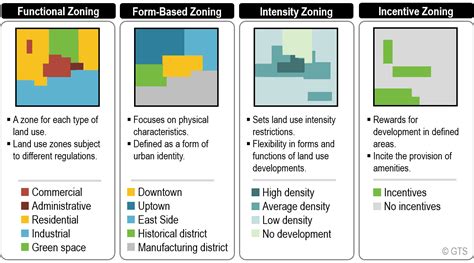Land use, the way in which humans transform natural landscapes for various purposes, plays a pivotal role in shaping our planet and societal well-being. Understanding the diverse types of land use is essential for effective land planning and management.

Urban Land Use
Characteristics:
- Densely populated areas with high infrastructure and building density
- Dominated by residential, commercial, and industrial activities
- Characterized by high levels of urbanization and connectivity
Benefits:
- Concentrated access to services, employment, and transportation
- Reduced energy consumption per capita due to proximity and energy efficiency
- Promotes social and economic interactions
Considerations:
- Can lead to overcrowding, pollution, and infrastructure strain
- Limited access to green spaces and natural resources
- High cost of living and housing
Rural Land Use
Characteristics:
- Sparsely populated areas with low infrastructure density
- Dominated by agriculture, forestry, and mining activities
- Characterized by a close connection to the natural environment
Benefits:
- Preserves natural landscapes and agricultural productivity
- Supports rural livelihoods and food security
- Provides recreational opportunities and access to natural resources
Considerations:
- Can suffer from isolation and lack of access to services
- Vulnerability to climate change and natural disasters
- Limited employment opportunities outside of agriculture
Natural Land Use
Characteristics:
- Undisturbed or minimally disturbed ecosystems with minimal human intervention
- Includes forests, wetlands, oceans, and mountains
- Provides a wide range of ecological services
Benefits:
- Protects biodiversity and ecosystem resilience
- Regulates climate and water cycles
- Provides recreation and aesthetic value
Considerations:
- Can conflict with economic development and resource exploitation
- Requires careful management to preserve ecological integrity
- Susceptible to human interference and climate change
Mixed Land Use
Characteristics:
- Areas that combine different types of land use, such as urban-rural or rural-natural
- Blends residential, commercial, and industrial activities with agricultural or natural areas
- Encourages balanced development and resource sharing
Benefits:
- Promotes sustainable living by reducing sprawl and preserving natural environments
- Creates a diversity of lifestyles and economic opportunities
- Can provide buffer zones between urban and rural areas
Considerations:
- Requires careful planning to avoid conflict and maintain ecological integrity
- Can lead to fragmentation and isolation of natural habitats
- May have limitations on development density and infrastructure capacity
Smart Land Use Planning
As cities and towns continue to grow, smart land use planning is essential for creating sustainable and equitable communities. Key factors to consider include:
- Density and Compactness: Promoting higher densities and compact development reduces urban sprawl and preserves natural landscapes.
- Transit-Oriented Development: Encouraging development around public transportation hubs reduces traffic congestion and greenhouse gas emissions.
- Green Infrastructure: Integrating parks, greenways, and other natural areas into urban design provides environmental, social, and economic benefits.
- Mixed-Use Development: Combining different land uses in a single area creates vibrant and walkable communities that reduce the need for transportation.
Innovative Land Use Practices
In response to the challenges of urbanization and environmental degradation, innovative land use practices are emerging. These include:
- Vertical Farming: Urban farming techniques that utilize vertical space to cultivate crops in buildings, maximizing food production in dense urban areas.
- Urban Micro-Forests: Small, dense patches of trees planted in urban areas to improve air quality, reduce urban heat island effects, and enhance biodiversity.
- Edible Landscaping: Planting edible plants in public spaces and private gardens to provide access to fresh food and promote urban agriculture.
Data and Statistics
- According to the United Nations, urban areas are projected to house 68% of the world’s population by 2050.
- In the United States, residential land use accounts for approximately 39% of developed land, while agricultural land comprises 41%.
- Natural areas, including forests, wetlands, and oceans, cover approximately 40% of the Earth’s surface.
- Mixed land use areas have been shown to increase biodiversity by up to 40% compared to areas with only one land use type.
Tables
| Land Use Type | Characteristics | Benefits | Considerations |
|---|---|---|---|
| Urban | Densely populated, high infrastructure | Concentrated services, reduced energy consumption | Overcrowding, pollution |
| Rural | Sparsely populated, low infrastructure | Agricultural productivity, natural resources | Isolation, limited services |
| Natural | Undisturbed ecosystems | Ecological services, biodiversity | Resource conflict, climate change |
| Mixed | Combination of land uses | Sustainable living, economic diversity | Planning challenges, fragmentation |
| Innovative Land Use Practice | Description | Benefits | Considerations |
|---|---|---|---|
| Vertical Farming | Urban farming in buildings | Maximized food production, reduced sprawl | High energy consumption |
| Urban Micro-Forests | Dense tree patches in urban areas | Air quality improvement, biodiversity | Space constraints |
| Edible Landscaping | Planting edible plants in public spaces | Access to fresh food, urban agriculture | Limited food production |
FAQs
1. What is the most common type of land use in the world?
Agricultural land use covers the largest portion of developed land globally.
2. Why is land use important?
Land use directly affects human well-being, environmental sustainability, and economic development.
3. What are the main challenges of land use planning?
Balancing urban growth, preserving natural environments, and meeting the needs of different stakeholders.
4. What are the benefits of green infrastructure?
Improved air and water quality, reduced flooding, increased biodiversity, and enhanced aesthetics.
5. How can innovative land use practices contribute to sustainability?
By maximizing food production, reducing urban sprawl, and enhancing biodiversity in dense urban environments.
6. What is the role of technology in land use planning?
Geographic Information Systems (GIS) and satellite imagery provide valuable tools for data analysis and informed decision-making.
7. How can we ensure equitable access to land?
Policies and regulations that promote affordable housing, community land trusts, and urban planning that prioritizes social equity.
8. What is the future of land use planning?
Smart land use practices, innovative technologies, and a focus on sustainability will shape future land use planning and design.
